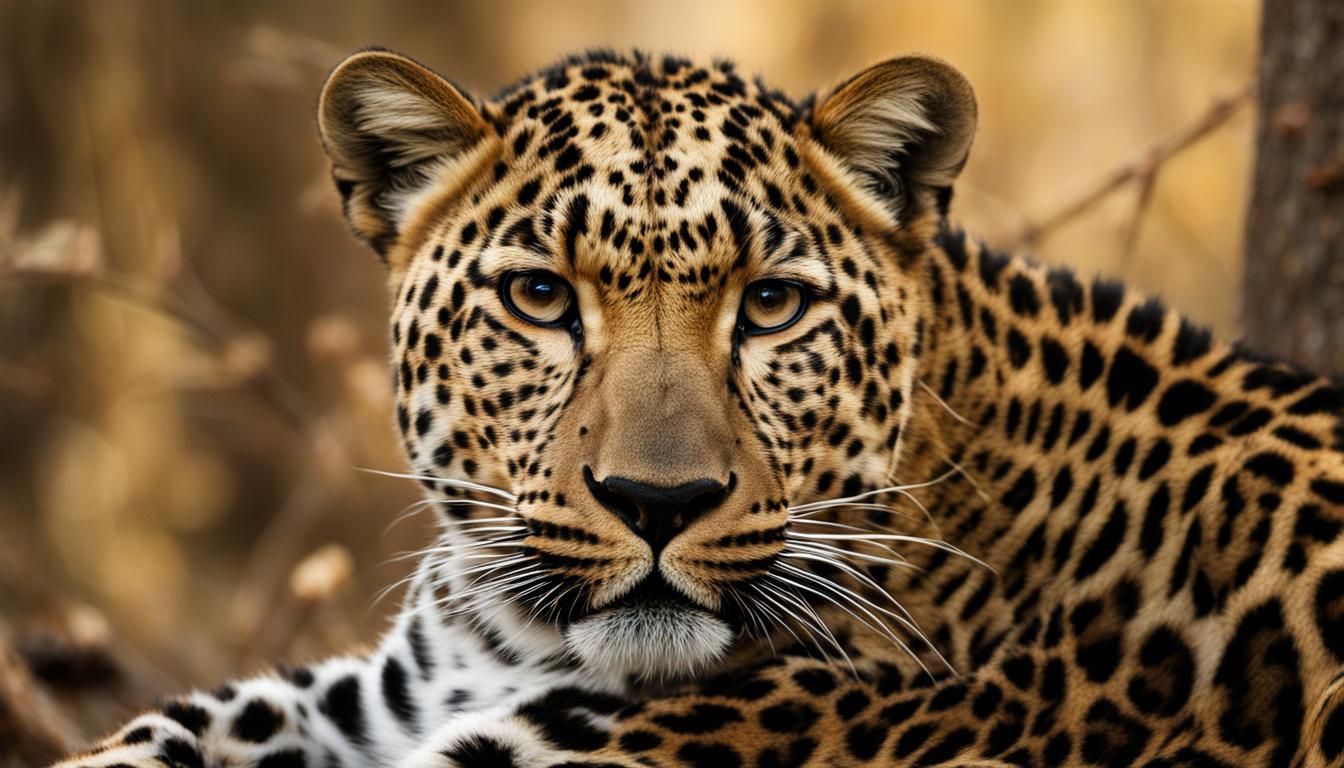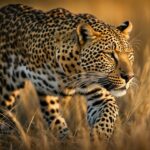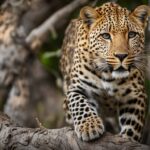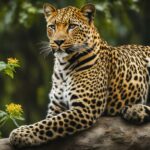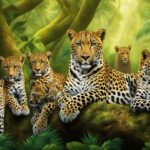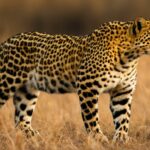In this article, we will explore the fascinating world of leopard fur and coloration. The leopard (Panthera pardus) is known for its stunning pale yellowish to dark golden fur, adorned with dark spots grouped in rosettes. But have you ever wondered why leopards have such unique fur patterns? Well, the answer lies in their remarkable adaptations for survival.
The coloration and spots of the leopard’s fur serve an important purpose – camouflage. Whether it’s the lush rainforests or the vast savannahs, the leopard’s fur allows it to blend seamlessly into its surroundings. This natural camouflage makes it easier for leopards to stalk and ambush their prey, giving them a hunting advantage.
But the significance of leopard fur doesn’t end there. The distinctive patterns and colors have also inspired fashion trends, with leopard prints and designs making a bold statement in the fashion industry. From leopard coats to leopard-inspired accessories, this exotic fur has found its way into our wardrobes.
So, join us on this journey as we dive deeper into the adaptations, physical characteristics, and geographic distribution of the leopard’s fur. Discover the wonders of nature’s design and the influence it has on both the wild and the world of fashion.
The significance of leopard fur pattern and color for survival
The unique fur pattern and coloration of leopards play a crucial role in their survival. The spots and rosettes help the leopard blend into the surrounding environment, making it difficult for prey to detect them. This camouflage allows leopards to approach prey closely without being noticed, increasing their chances of a successful hunt. Additionally, the distinctive leopard fur pattern has inspired fashion trends, with leopard prints and designs often used in clothing and accessories.
The animal print created by the leopard’s fur has long been associated with exoticism and luxury. Leopard coats, for example, have been coveted for their timeless elegance and bold style. The use of leopard-inspired design in fashion showcases the power and allure of these magnificent creatures. Whether it’s a leopard-inspired dress, handbag, or pair of shoes, the animal print adds a touch of sophistication and wildness to any outfit.
Leopard prints have become a symbol of confidence and individuality, representing the fierce and independent nature of those who wear them. The combination of the leopard’s unique fur pattern and its association with exoticism has made it a sought-after design element in the fashion industry. From runways to street style, leopard-inspired designs continue to be a popular choice for those looking to make a bold fashion statement.
The allure of leopard-inspired design
Leopard-inspired design not only captures the essence of the leopard’s fur pattern but also embodies its spirit. The bold spots and striking coloration of the leopard’s coat have inspired designers to create captivating patterns that evoke a sense of adventure and untamed beauty. Whether it’s in clothing, accessories, or home decor, leopard-inspired design adds an element of intrigue and sophistication to any setting.
| Leopard-Inspired Fashion Items | Description |
|---|---|
| Leopard Print Dress | A classic wardrobe staple that showcases the timeless allure of leopard-inspired design. |
| Leopard Print Handbag | An eye-catching accessory that adds a touch of wild elegance to any outfit. |
| Leopard Print Shoes | A bold statement piece that elevates any ensemble with its fierce and fashionable appeal. |
Leopard-inspired design allows individuals to express their unique style and embrace their inner wild side. It serves as a reminder of the beauty and power of nature, creating a connection between fashion and the natural world. So, whether you opt for a leopard print dress or add subtle leopard accents to your accessories, embrace the allure of leopard-inspired design and unleash your inner feline.
Adaptations of leopard fur for camouflage
The leopard’s fur pattern and coloration are perfectly adapted to provide camouflage in different habitats. This remarkable adaptation ensures that leopards can effectively conceal themselves and remain unseen by both prey and potential predators.
In forests and mountains, where shadows and dense vegetation prevail, leopards have darker and deeper golden fur. This allows them to blend seamlessly into their surroundings, making it difficult for their prey to detect them. The rosette patterns on their fur further enhance their camouflage, breaking up their silhouette and creating an illusion of dappled sunlight filtering through the foliage.
Conversely, in arid and open habitats such as deserts and grasslands, the leopard’s fur is paler in color. Ranging from cream to yellowish and ochraceous, their fur perfectly matches the dry and sandy environment. This adaptation helps them merge with the golden hues of the savannah or the distinct patterns of the desert landscape.
Leopard fur showcases the incredible diversity and adaptability of nature. The unique patterns and colors of their fur allow them to seamlessly blend into different habitats, providing them with a distinct advantage in their search for prey and protection from potential threats.
Table: Leopard Fur Adaptations for Camouflage
| Habitat | Fur Color | Pattern |
|---|---|---|
| Forests and Mountains | Darker and deeper golden | Rosette patterns |
| Arid and Open Habitats | Paler cream, yellowish to ochraceous | Camouflaging coloration |
The adaptability of leopard fur is a testament to the incredible evolutionary processes that have shaped these magnificent creatures. Their unique fur patterns and colors not only aid in their survival but have also inspired human creativity, with leopard prints and designs often used in fashion and interior design.
Understanding the incredible adaptations of leopard fur for camouflage allows us to appreciate the intricate beauty of nature and the remarkable ways in which animals have evolved to thrive in their respective environments.
Physical characteristics of leopard fur
Leopard fur is renowned for its unique physical characteristics, which make it both visually striking and highly functional. The fur is generally soft and thick, providing insulation and protection for the leopard in various climates and terrains. Its color ranges from a pale yellowish hue to a deep golden shade, adapting to the specific habitat in which the leopard resides.
The most distinctive feature of leopard fur is undoubtedly the black spots arranged in rosette patterns. These spots are strategically placed on the leopard’s body, with no spot in the center, creating an eye-catching and recognizable pattern. The size and shape of the spots can vary, adding to the individuality of each leopard’s fur coat.
Leopard fur also exhibits variations in texture across different parts of the body. The fur on the belly is generally softer compared to the fur on the back, allowing for greater comfort while resting or moving. This contrast in texture adds to the overall aesthetic appeal of the leopard’s fur coat.
| Physical Characteristics | Description |
|---|---|
| Fur Color | Pale yellowish to dark golden |
| Fur Texture | Soft and thick |
| Spot Pattern | Black spots in rosette patterns |
| Spot Size | Varies across individuals |
| Texture Contrast | Softer belly fur compared to back fur |
The distinctive physical characteristics of leopard fur have not only facilitated their survival in the wild but have also inspired the fashion industry. Leopard-inspired designs have been popular for many years, with leopard prints adorning clothing, accessories, and home decor. The allure of leopard fur extends beyond its functional benefits, captivating the human imagination and showcasing the innate beauty of nature.
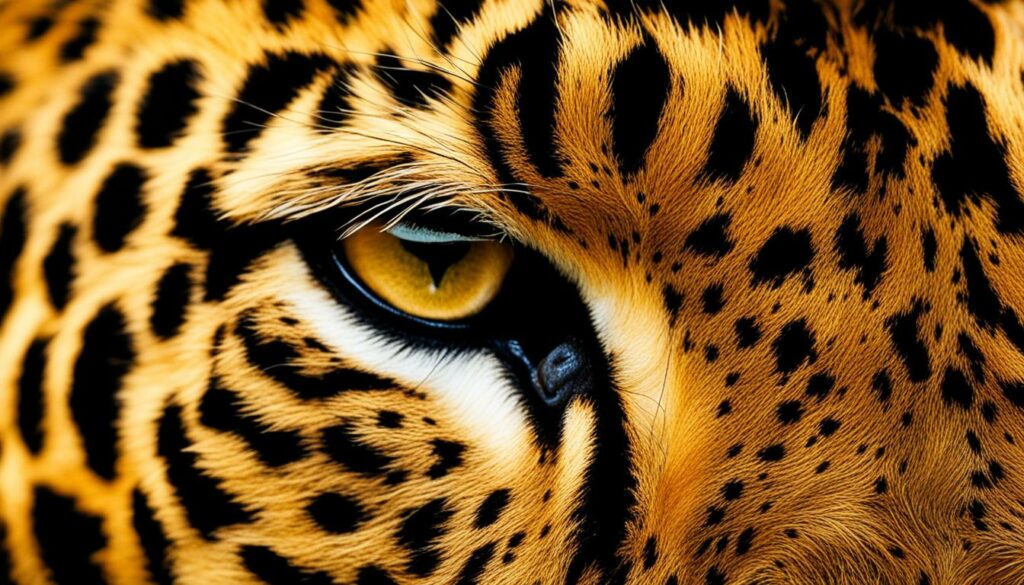
Natural Inspiration for Fashion
Leopard fur has remained a timeless source of inspiration in the world of fashion. Its bold pattern and rich color palette have found their way into numerous collections, adding a touch of exoticism and glamour. Designers often incorporate leopard-inspired elements, such as prints and texture, to create captivating pieces that evoke a sense of wildness and sophistication.
“Leopard print is a neutral.” – Jenna Lyons
- Leopard print has become a staple in the fashion world, with its versatility allowing it to be paired with a wide range of colors and styles.
- The distinctive combination of spots and golden hues provides a unique visual appeal, making leopard prints instantly recognizable and eye-catching.
- From clothing and accessories to shoes and handbags, leopard-inspired designs continue to captivate fashion enthusiasts and make a statement.
Whether in the wild or on the runway, leopard fur remains a symbol of beauty, adaptability, and untamed allure. Its physical characteristics have not only allowed leopards to thrive in their natural habitats but have also inspired countless designers and fashion enthusiasts around the world.
The Geographic Distribution and Habitat of Leopards
Leopards are incredibly versatile big cats, found in at least 80 countries across Africa, the Middle East, Far East, and parts of Asia. Their adaptability is largely due to their unique fur pattern and coloration, which allows them to blend seamlessly into a wide range of environments.
In terms of habitat, leopards can be found in various ecosystems, including rainforests, savannahs, grasslands, mountains, and deserts. Each of these habitats presents its own set of challenges, but the leopard’s fur enables it to remain concealed and camouflaged in all of them. Whether it’s the lush greenery of a rainforest or the golden hues of a desert landscape, the leopard’s fur helps it effectively blend in with its surroundings.
The color variation in the leopard’s fur is particularly noteworthy. In forests and mountains, leopards have darker fur, ranging from deep golden to brown, allowing them to disappear into the shadows and dense vegetation. On the other hand, leopards inhabiting arid and open habitats like savannahs and deserts have paler fur, ranging from cream to yellowish or ochraceous, which helps them blend into the dry and sandy surroundings.
The Camouflage Advantage
The camouflage provided by the leopard’s fur is essential for its survival. By blending into their surroundings, leopards can effectively hide from both their prey and potential predators. This ability allows them to approach their prey closely without being detected, increasing their chances of a successful hunt. Their unique fur pattern and coloration have also inspired fashion trends, with leopard prints often being used to create stylish and eye-catching designs.
The Remarkable Adaptations of Leopard Fur
The geographic distribution of leopards and their ability to thrive in diverse habitats is a testament to the remarkable adaptations of their fur. Their unique fur pattern and color not only provide camouflage but also aid in regulating body temperature. The dense fur helps insulate the leopard in colder climates, while its lighter color reflects sunlight and keeps the animal cooler in hotter environments.
Conclusion
The fur and coloration of leopards are not just essential for their survival but have also influenced the world of fashion. The unique rosette patterns and color palette of the leopard’s fur have inspired countless designers and made leopard prints and styles extremely popular in the fashion industry.
Leopard-inspired designs can be seen in clothing, accessories, and even home decor, adding a touch of exotic elegance to various products. The allure of the leopard fur pattern is undeniable, capturing the attention and imagination of many.
Furthermore, the adaptability of the leopard’s fur to different habitats showcases the remarkable evolutionary adaptations of this majestic big cat. The fur’s ability to blend into various environments, whether it be the lush foliage of a rainforest or the arid landscapes of a desert, is a testament to the leopard’s survival instincts.
Overall, the leopard’s fur and coloration are not only functional adaptations but also symbols of beauty and inspiration. From the wild habitats they call home to the runways of the fashion world, the leopard’s fur continues to captivate and influence our lives.
Do Leopard and Cheetah Fur Serve the Same Purpose in the Wild?
Leopard and cheetah fur, dappled with unique patterns, merge with the savannah’s palette for stealth and survival. While both offer camouflage, the role of cheetah fur coloration specifically aids in dissipating heat during high-speed chases, a testimony to the nuanced adaptability of these magnificent predators in the wild.
FAQ
What is the role of the leopard’s fur and its coloration?
The leopard’s fur and coloration serve as camouflage in various habitats, helping them blend into their surroundings and making it easier to stalk and ambush their prey.
What is the significance of leopard fur pattern and color for survival?
The unique fur pattern and coloration of leopards play a crucial role in their survival by allowing them to blend into their environment, making it difficult for prey to detect them and increasing their chances of a successful hunt. Leopard prints and designs have also inspired fashion trends.
How does leopard fur adapt for camouflage?
The fur pattern and color palette of leopards are adapted to provide camouflage in different habitats. In forests and mountains, they have darker and deeper golden fur, which helps them blend into shadows and dense vegetation. In arid and open habitats, their fur is paler cream or yellowish to match the dry and sandy surroundings.
What are the physical characteristics of leopard fur?
The leopard’s fur is generally soft and thick, ranging in color from pale yellowish to dark golden, with black spots arranged in rosette patterns. The fur is softer on the belly than on the back. The tail has a white underside, while the rest of the body is covered with various-sized black spots.
Where are leopards found and what habitats do they inhabit?
Leopards have a wide distribution, found in at least 80 countries across Africa, the Middle East, Far East, and parts of Asia. They inhabit a variety of habitats, including rainforests, savannahs, grasslands, mountains, and deserts.
What is the conclusion about leopard fur and color?
The fur and coloration of leopards play a crucial role in their survival, providing camouflage and allowing them to blend into their surroundings. The unique rosette patterns and color palette of the leopard’s fur have inspired fashion trends and designs, making leopard prints and styles popular in the fashion industry. The adaptability of the leopard’s fur to different habitats showcases the remarkable evolutionary adaptations of this iconic big cat.

